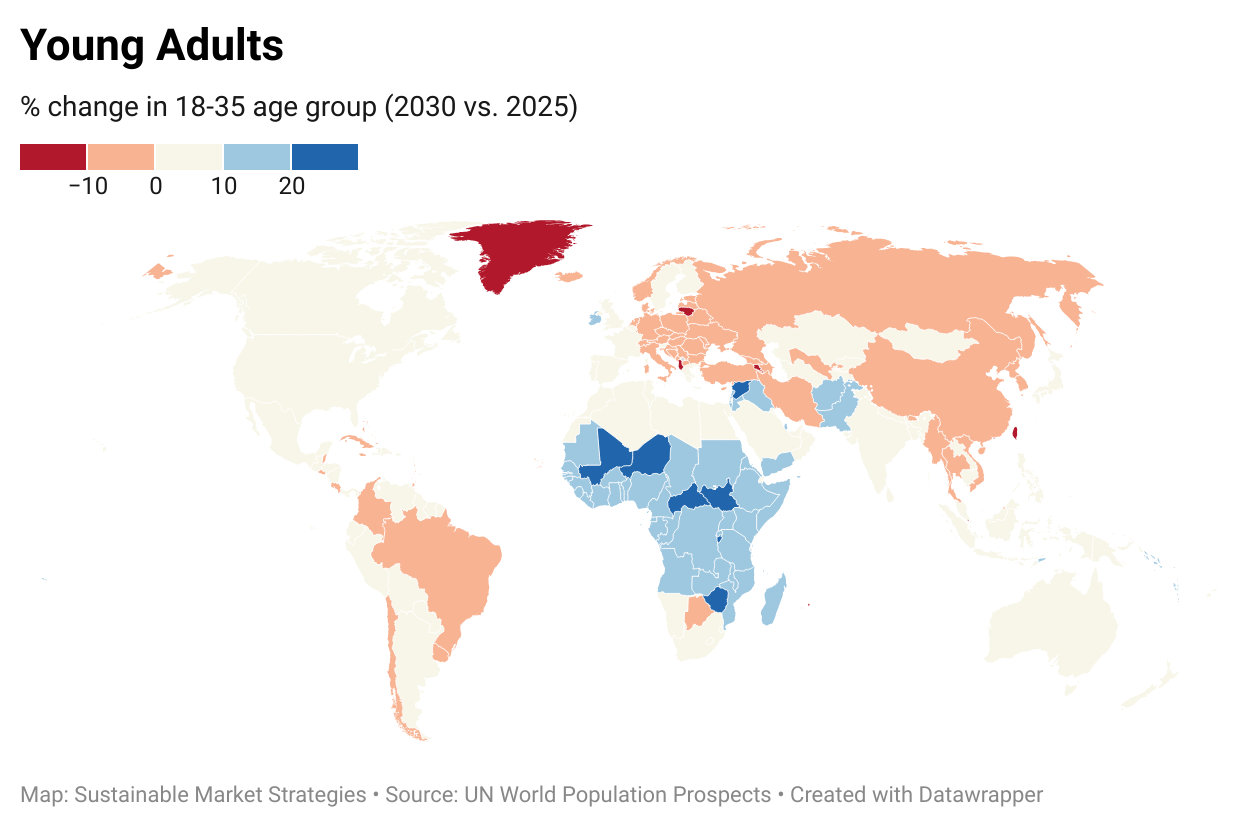Our analysis focuses on the next five years. Demographic changes are happening swiftly.
In 2024, global population growth was 0.8%. If we take the most realistic population growth view of the United Nations, global population will peak at around 9 billion people around 2050. This means population growth will be approximately 0.4% per year for the next 25 years, compared to 0.8%, now. Essentially, population growth will stop in 10–15 years, while aging continues.
The chart below shows the number of children per woman by country. The replacement rate to maintain a stable global population without improvements in life expectancy is around 2.1. As we can see, most countries have a fertility rate below 2.1, except for Africa, the Middle East, the "Stans", and a few countries in South America like Venezuela. South Korea is at 0.6 children per woman, China is a 1, Canada is at 1.3, Mexico has come down to 1.6 and the United States remains stable at that same 1.6 level.
Unsurprisingly, the number of children per country projected to 2030 will fall almost everywhere; South Korea and China will be most negatively affected with drops greater than 20% in just 5 years.
The picture for young adults is slightly more positive; North America, Australasia and Western and Southern Europe will experience a small decrease in young adults (new workers). China, Russia and Eastern Europe will have a lot less young adults while Africa will experience growth. Not a lot of new workers incoming to replace retirees in developed countries.
As for adults, most countries will have a growing population for the 36-53 age group except for Russia, Asia and many European countries.
Surprisingly, mature adults (54-71) will see a drop in Canada and the United States but will rise most everywhere else. If we combine the last 3 maps, we can see that the workforce in Europe and Asia will shrink over the next 5 years, it will remain stable in North America but will grow in Africa
One part of the population where there is very little distinction between countries is for people 72 and over. The number of older people will significantly increase in the next five years.
What does all of this demographic data mean?
1. Economic Effects
a. Shrinking Workforce
Declining Labor Supply: decline in the working-age population, leading to labor shortages.
Industries reliant on large, youthful workforces (e.g., manufacturing, agriculture) may face production bottlenecks.
Aging populations could reduce overall economic productivity.
Labor shortages may accelerate investment in automation, artificial intelligence, and robotics to offset workforce declines.
b. Slower Economic Growth
Reduced Consumer Demand: Aging populations typically consume less, especially in discretionary spending like luxury goods and travel.
c. Fiscal Strain
Increased Dependency Ratios: With fewer workers supporting a growing elderly population, governments face higher costs for pensions, healthcare, and social services.
Higher Taxes: Governments may need to increase taxes or cut public spending to address fiscal imbalances, potentially leading to economic inequality.
d. Resource Allocation Shifts
Changing Investment Needs: Reduced population growth could shift investment priorities from building infrastructure to healthcare and elder care.
2. Social Effects
a. Aging Populations
Healthcare Systems Under Pressure: healthcare systems will need to adapt sooner to meet the needs of an older population.
Social Security Systems: Pensions and retirement systems will need reform, with potential tensions between younger workers and older retirees.
b. Shifting Family Structures
Smaller Families: With lower fertility rates, family sizes shrink, and the burden of elder care often falls on fewer children, exacerbating caregiving challenges.
3. Political Effects
a. Changing Political Priorities
Aging Dominates Agendas: Older populations may demand policies focused on healthcare, pensions, and social services, potentially sidelining issues like education and youth programs. As younger populations decline, intergenerational tensions may rise over resource allocation and political representation.
4. Accelerated Need for Innovation
Healthcare Technology: an aging population will mean faster development of technologies to support aging populations, such as telemedicine, wearable devices, and AI-driven healthcare.









